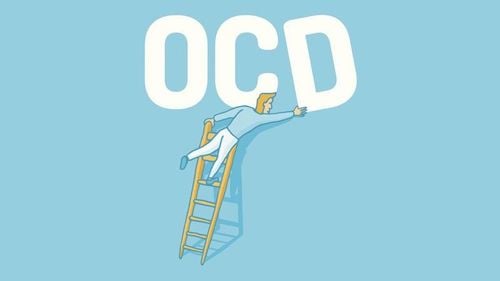This is an automatically translated article.
Obsessive-compulsive disorder (OCD) is an anxiety disorder affecting 2 - 3% of the world's population. Obsessive-compulsive disorder usually begins in late childhood or early adolescence. Does obsessive-compulsive disorder get worse with age? Read on to learn more about this disease.1. Symptoms of Obsessive Compulsive Disorder
People with obsessive-compulsive disorder experience repetitive and persistent thoughts, images, or impulses that are intrusive and undesirable. It is estimated that over 6 million people in the United States have an obsessive-compulsive disorder (OCD). Men and women develop obsessive-compulsive disorder at equal rates and the disease has been observed in all age groups, from school-age children to the elderly.Obsessive-compulsive disorder usually begins in adolescence but can also present in adulthood or childhood. The onset of obsessive-compulsive disorder is usually gradual, but in some cases, it can start suddenly. Symptoms fluctuate in severity over time, and this variability may be related to the occurrence of prolonged stressors. Because symptoms often worsen with age, it can be difficult for people to remember when it started, but sometimes, they can recall the first time they noticed symptoms that were disrupting their lives. . Typical symptoms of obsessive-compulsive disorder include:
Unreasonable suspicion or discomfort. Think about harm, pollution, sex, religious or health topics. Habits such as excessive cleansing, checking, praying, repeating routine activities. Negative thoughts. Additionally, you may be aware of certain situations, places, or objects that trigger distressing thoughts. You may find yourself avoiding these situations, places, and objects.
2. Causes of Obsessive Compulsive Disorder
To find out why some people develop obsessive-compulsive disorders while others do not, researchers considered different hypotheses. Experts have suggested that certain "mistakes in thinking" about harm happen to people with obsessive-compulsive disorder. Examples of such mistakes in thinking are:Thinking of an action as doing or wanting to do it. Everyone should control their thoughts. If I don't try to prevent the harmful effects of something, that is no different from harm. A person is responsible for causing harm, regardless of the circumstances. This theory explains the kinds of errors in the thinking of people with obsessive-compulsive disorder, but it doesn't explain why some people have obsessive-compulsive disorder and others don't. Many researchers also feel that people with obsessive-compulsive disorder have abnormal levels of brain chemicals related to serotonin, a chemical important for brain functioning.
Abnormal serotonin levels have been observed in people with obsessive-compulsive disorder. Medications that relieve OCD symptoms also change serotonin levels. However, it is still not clear whether serotonin is really a key factor in the development of obsessive-compulsive disorder. Research results are inconclusive at this time. There is also evidence that obsessive-compulsive disorder is more common in some types of families than in others. It is difficult to know what percentage of this is the result of what children learn from their families as they grow up and how much is genetic.

Có nhiều giả thiết được đặt ra để giải thích cho việc xuất hiện căn bệnh rối loạn ám ảnh cưỡng chế
Scientists have a very good understanding of the symptoms of obsessive-compulsive disorder and that is important for the treatment of this disorder. In fact, learning more about the symptoms of obsessive-compulsive disorder will help us further improve our treatments. Obsessive-compulsive disorder is a collection of habits, involving unwanted and irritating intrusive thoughts, ideas, images, or impulses (obsessions).
Along with these thoughts, the person experiences extreme discomfort or unwanted anxiety and is forced to do something to relieve the anxiety. As a result, people have a habit of using many different particular thoughts or actions to try to get rid of anxiety (compulsions). These habits of thinking, feeling, and acting are extremely annoying, wasteful, and hard to get rid of on your own.
4. Two types of association in obsessive-compulsive disorder
These two types of associations are a very important part of obsessive-compulsive disorder and understanding them will help our therapy. Therapy is designed to break both types of bonds. The first type is the association between certain objects, thoughts, or situations with anxiety/discomfort. For example, think of a situation, thought, or object that you try to avoid or you suffer because it makes you feel anxious or uncomfortable. Thus, it is possible that such situations are related to your anxiety and depression.The second type of association is the link between practicing habits (compulsions) and reducing suffering. In other words, after implementing those habits, you temporarily feel less miserable. Therefore, you continue to do this behavior regularly to gain relief. Try to identify situations that increase the discomfort (first link) and then the behaviors or thoughts you take to neutralize the discomfort (link number 2). Doing this will help increase the effectiveness of obsessive-compulsive disorder therapies.
Unfortunately, implementing habits to reduce suffering doesn't really work. The patient's sadness may subside for a short time, but will continue to recur. Often, they find themselves doing more and more of those habits to try to get rid of their anxiety. Even so, these habits do not alleviate suffering, and soon the sufferer will find himself in a position to spend so much time and energy on such behaviors that life is seriously disrupted. .
To treat obsessive-compulsive disorder, the links described above must be weakened or broken. Therapy is designed to do this, and doctors know exercises that will be helpful in achieving this goal. These exercises are called “exposure prevention” and will be presented to the patient when they are ready to apply the therapies

Liệu pháp phơi nhiễm thường được sử dụng để điều trị rối loạn ám ảnh cưỡng chế
5. Obsessive Compulsive Disorder and Age
As for the age of onset as well as whether obsessive-compulsive disorder becomes more severe with age, many experts have studied this issue and have reached different conclusions:Progress According to doctor Jeff Szymanski, obsessive-compulsive disorder can begin at any time, from preschool to adulthood. Although obsessive-compulsive disorder occurs at earlier ages, there are generally two ages when obsessive-compulsive disorder first appears: 10 to 12 years of age and late adolescence to early childhood manhood. Obsessive-compulsive disorder also shows no signs of worsening with age. Dr. Jonathan Abramowitz said: Obsessive-compulsive disorder usually begins between the ages of 18 and 25 but can appear at any time. I've seen kids around 6 or 7 years old with the disease. It's less likely to show up for the first time as you get older, except when women are pregnant and giving birth, they're more likely to develop symptoms of obsessive-compulsive disorder. Dr. Steven J. Brodsky : The average age of onset is 7 years old, in some cases still an infant. Often people think it develops later in life but that is only when outward symptoms are identified. Many times, people mistakenly believe that their obsessive-compulsive disorder has magically gone away for years and then it comes back. In fact, all they think is gone is the circumstances, habits, context, and causes of their OCD, but all the symptoms return when circumstances change again. Usually, this can happen around life ups and downs. Sometimes, obsessive-compulsive disorder is manageable but then becomes acute due to other problems such as pregnancy and childbirth.
Dr. Charles H. Elliott and Laura L. Smith: Obsessive-compulsive disorder usually occurs in childhood, however, it is relatively rare before the age of 4 or 5. Although people can develop the Obsessive-compulsive disorder symptoms at any time in life, but symptoms usually appear in adolescence, if not childhood. Dr. Kenneth Schwarz: Obsessive-compulsive disorder symptoms can begin at any age, even in later adulthood. The usual time of onset is in adolescence and boys tend to have earlier onset than girls. For children under adolescence, the symptoms of obsessive-compulsive disorder are similar to those experienced by adults. Dr. Charlotte M. Scott : Obsessive Compulsive Disorder Without Age Identification; Severe trauma and grief can cause disorders at any age. Although it may seem that fears, phobias, and compulsions can be "learned" by children and adolescents in the family of someone with OCD. It usually persists throughout a person's life with periods of mild symptoms interspersed with periods of severe symptoms.

Có nhiều ý kiến khác nhau được đưa ra về mối liên hệ giữa OCD và tuổi tác
Psychological Clinic - Vinmec Times City International General Hospital is an address for examination, consultation and treatment of psychological and mental health diseases that is chosen and appreciated by many people today.
This is an outpatient treatment center, the clinic is invested with a system of modern equipment and facilities, in order to create a comfortable space for patients to examine and consult, to easily open their hearts and share their problems. Psychological pressure, effective support for the treatment process. The clinic owns a team of medical doctors, psychologists from leading hospitals and centers in the country. Among them are many lecturers and professors teaching psychiatry at Hanoi Medical University. With experience and high professional ability, the medical team at the Psychology clinic - Vinmec Times City International General Hospital will help shorten the treatment process and improve treatment efficiency. The clinic is capable of deploying psychological tests and intensive psychotherapy for medical examination and treatment.
Please dial HOTLINE for more information or register for an appointment HERE. Download MyVinmec app to make appointments faster and to manage your bookings easily.
References: med.upenn.edu, livescience.com, betterhealth.vic.gov.au












